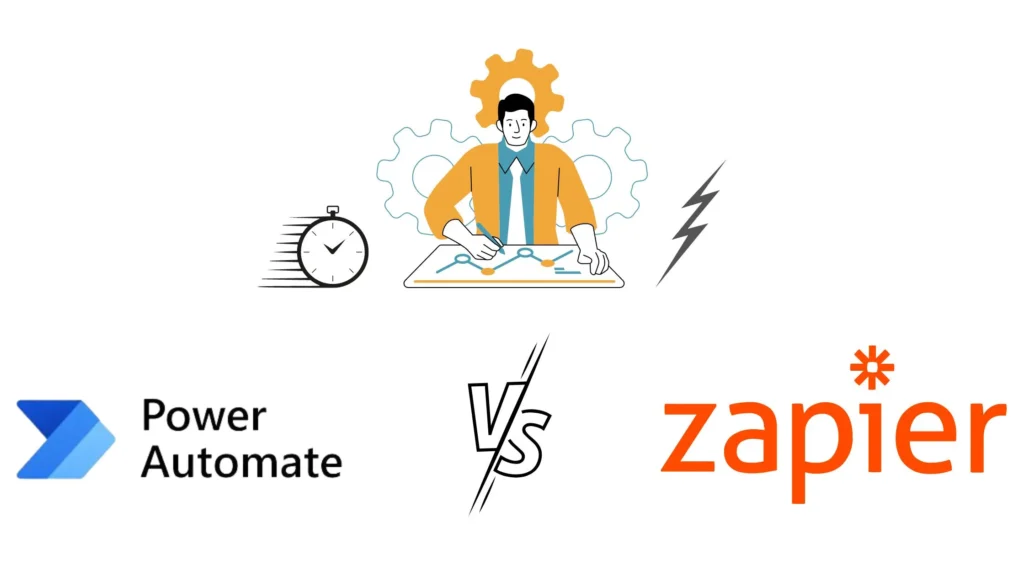You want to compare both Microsoft Power Autmate vs. Zapier, right?
If so, Congrats! You’ve landed in the right place. At the end of this blog post, you will choose the best workflow automation tool for your business needs.
Let’s start with Microsoft Power Automate.

What is Microsoft Power Automate?
Microsoft Power Automate is a workflow automation tool allowing you to create automated workflows between various applications and services.
It allows integration well with other Microsoft products such as Excel, SharePoint, and Dynamics 365.
With Microsoft Power Automate, formally known as Micorosft flow, you can automate repetitive tasks and streamline their workflows without being stuck on them.
To create workflows with Power Automate, you don’t have to have a good understanding of any coding or programming knowledge.
The workflows can include sending emails, creating tasks, updating databases, posting on social media, etc.
What are Power Automate’s advanced features?
In addition to workflow automation, Power Automate also offers advanced features such as AI Builder and Power Apps.
AI Builder allows users to build custom AI models to automate processes, while Power Apps enables users to create custom business applications.
Is Microsoft Power Automate free?
Power Automate isn’t free and offers various pricing plans based on usage and functionality.
The plans range from a free plan with basic features to a premium plan with advanced capabilities.
Microsoft will give you a 30-day free trial to test its capabilities and performance.
The free plan allows users to create unlimited flows but with a monthly run limit of 750 runs.
The plan also includes access to over 100 data sources and premium connectors and the ability to create custom connectors.
What is Zapier?
Zapier is a web-based automation tool that allows businesses to connect different applications and automate workflows without requiring any coding knowledge.
It also offers a user-friendly interface that enables users to create workflows by setting up triggers and actions between different apps.
One of the exciting things is Zapier integrates with over 2,000 applications, including;
- Slack
- Trello
- Mailchimp
- Salesforce
… and so on.
Zapier allows you to create zaps, workflows that automate tasks between two or more applications.
For example, you can create zaps that automatically add new email subscribers to a Google Sheets spreadsheet or sends a Slack notification when a new task is added to a Trello board.
On the other hand, Zapier offers a wide range of pre-built templates, making it easy for non-technical users to create complex workflows.
What are Zapier’s advanced features?
In addition to the basic features, here are some more advanced features from Zapier;
- Multi-step zaps – This feature allows users to create workflows with multiple actions and triggers.
- Filters – Zapier’s filter feature allows users to specify certain conditions that must be met before a workflow is triggered.
- Conditional logic – This feature allows users to create more complex workflows by adding if/then statements.
- Formatter – Zapier’s format allows users to manipulate data as it moves through their workflow.
- Paths – This feature allows users to create workflows with multiple outcomes based on different conditions.
Can I use Zapier for free?
Yes, you can use Zapier for free with limited functionalities, which include 100 tasks per month and support for up to five zaps.
Zapier offers various pricing plans based on usage and functionality.
Paid plans start at $19.99 monthly and offer higher usage limits and more advanced features.
What is the difference between Power Automate and Zapier?
Power Auotmate and Zapier are workflow automation tools specifically designed to automate repetitive tasks between various applications.
However, there are some critical differences between the two tools:
- Integration Options – Power Automate has a more robust integration with Microsoft products like Office 365, Dynamics 365, and Power BI. On the other hand, Zapier offers a broader range of third-party app integrations.
- Pricing Plans – Power Automate offers a free plan with limited functionality, while Zapier’s free plan includes more features and higher usage limits. Zapier’s paid plans are also generally less expensive than Power Automate’s, making it a more affordable option for small businesses.
- Advanced Features – Power Automate offers advanced features such as AI Builder, which allows users to create custom AI models, and UI flows, enabling users to automate tasks within web applications. Zapier, on the other hand, offers advanced features like multi-step zaps, filters, and paths.
- Ease of Use – Both tools are user-friendly and require no coding knowledge. However, Zapier is generally considered easier to use due to its intuitive interface and pre-built templates.
Microsoft Power Automate vs. Zapier: Which one is best for beginners?
If you are new to automation and already using Microsoft products, Power Automate is an excellent choice for getting started with workflow automation.
Power Automate and Zapier are designed to be user-friendly and accessible to beginners.
The exciting thing is Power Automate offers a wide range of pre-built templates and connectors that make it easy for beginners to get started.
It’s time to automate workflows with Power Automate

Let AAARM Tech do the heavy lifting for you and spend your time with more freedom.
You have nothing to worry about creating workflows, Power Automate and AAARM Tech support makes it easy to create workflows even if you have no experience with automation tools.











